Winter Attempts on Rainier
If I was fortunate in climbing Rainier in good weather during Spring and
Summer,
the opposite was true for Winter attempts.
Winter weather in the Washington Cascades is generally bad.
There few qualified climbers interested in the hardships and risks one
expects in a Winter climb of Rainier.
Of those,
most have jobs and want to schedule a long weekend some time in advance.
But the weather does not respect schedules,
so it is difficult to have a team ready to go at a time the weather is
good.
Add to this list the fact that the weather forecasts are notoriously
inaccurate and the forecasts are for lower elevations,
which does not reflect what is happening high on Rainier.
Combinations of these problems were factors in all three attempts I
made.
18 March 1971
I was invited to a Winter climb of Rainier led by
Bruce Carson.
Starting in the dark Thursday night at 8:00PM,
we began a slow ascent to
Camp Muir.
We were all sleepy and tended to zig-zag a bit in the dark.
We picked up ropes and fuel Carson had cached at 9,000 feet and finally
made it to Camp Muir
(10,000 feet)
at 8:00AM.
We found the stone hut unoccupied but filled with large drifts of snow
that had filtered in around cracks in the door;
the dry snow is blown like sand by the high winds at 10,000 feet.
We shoveled enough snow out to climb in through the window of the Dutch
door and laid out our sleeping bags on the wooden bunks.
We woke at 11:00PM and set out for the summit about 1:00AM.
The snow was 6" to 1' deep except in the steep sections.
Soon one of my crampons came off;
I was using new straps with buckles that would be easier to fasten
without taking off gloves.
It's usually a bad idea to take new,
untested equipment on a big climb and this proved it.
I tied both crampons on with knots,
knowing I would have to cut the straps later to get them off,
and had no further problems.
The blowing snow created a sensation of drowning,
as one tended to inhale large amounts of snow with each breath.
Our frame packs caught the wind,
making us unsteady on our feet.
We got nearly to 12,000 feet when the wind gusted to the point I had to
lay down to keep from getting blown away.
I was concerned the others on my rope would continue on and look back to
see me laying in the snow when the rope came tight,
but when the blowing snow cleared I looked up to see them laying in the
snow like me.
The wind gusts grew stronger and we all had to lay down during gusts to
keep from being blown away.
At about 3:00AM Carson said we should turn back,
citing my troubles with crampons as one reason.
I protested mildly,
but turning back seemed the right thing to do,
so I did not make much fuss.
Being last on the last rope going up,
I wound up leading the way down.
Everyone got frustrated with my slow progress,
but they could not see my problem:
the wind was blowing so hard the wands we had placed were vibrating so
rapidly they were not visible in the low light.
I had to listen for the humming noise they made to locate them.
Everyone was discouraged,
so we packed up and were back at
Paradise
by 9:00AM.
I felt we should stay at Camp Muir and make another attempt the following
day;
the weather seemed to improve,
so perhaps we could have made it had we endured another day at Muir.
I was disappointed when Carson later commented that a stronger team
would have made the summit,
since it was clear that everyone was having problems with the wind when
we turned around and the situation would likely have been worse higher up.
A stronger team would have been blown away as easily as us,
but a stronger team would have regrouped for an attempt the following day.
1972 Attempts
I led two attempts before Spring of 1972;
we did not reach Camp Muir on either of them.
First 1972 Attempt

On the first attempt we began our ascent to Muir at night,
one person on skis and the rest on snow shoes.
The wind at 7,000 feet was so fierce that it picked up snow slabs,
hurling them across the slopes;
the slabs pummelled us and coated us in wet snow.
The temperature was close to freezing,
so the snow was melting on us,
decreasing the wind effect temperature to much lower levels.
We retreated from the beating we were taking and spent a night in the
restrooms at
Paradise.
The skier had left his skis at our turn-around point because it was too
windy to ski on them and they were like sails if he tried to carry them.

The weather was fine the next morning–
the good weather we had been expecting was a day late.
The majority of the party was unwilling to start our climb a day late.
We hiked back up to the turn-around point to collect the flags we had
placed and retrieve the skis.
This picture shows how close together we were placing flags and how we
were starting to veer wildly off course at the time we turned back.
I have connected the flags with red lines to identify them.
Second 1972 Attempt
– Saved by a Cup of Tea –
The second attempt was much worse.
We were again confronted with high winds coupled with heavy snow as we
started for Camp Muir.
Visibility was so bad we decided to turn back;
we did not have GPS in those days,
so our chances of finding Camp Muir were slim at best.
As I led the descent,
I heard yelling behind me.
I turned to see what the commotion was and saw the other members of the
party receding up the slope–
I was standing in the middle of a slab avalanche.
I immediately fell on my back and started shedding my pack,
but the avalanche came to a stop without breaking up.
We tried to continue the descent but the avalanche threat seemed to
increase by the minute and snow was falling very heavily.
We finally decided to stop in what appeared to be a relatively safe spot
to dig snow caves and wait for better conditions.

There were 5 in the party.
I partnered with Fred to dig a cave while the other 3 dug their
cave nearby.
We completed our cave and got situated inside.
Fred just wanted to rest and climbed into his sleeping bag.
I knew hydration was important after the effort we had been through,
and a hot drink would calm us down for the night.
I started up the stove but before the snow melted the stove went out.
I tried to re-light the stove,
but the matches would not burn!
Several attempts produced the same result;
my brain cells were operating just well enough to finally realize we were
running out of oxygen.
Had I climbed into my sleeping bag we might have dozed off never to
waken.
I tried to open the cave entrance to let in air and found it completely
clogged with snow.
Fred panicked and started frantically digging out;
he was so out of control that I got out of his way and packed our
sleeping bags and other gear away to keep them from being filled with
the snow he was throwing back into the cave.
After we got out,
I dug out the other snow cave and warned them that they would need to
keep watch and make sure they got air through the night.
Our cave was filled with snow from digging out so we essentially had to
dig it again.
It was difficult convincing Fred to get back into the cave.
To ease both our minds,
I set my alarm for 1 hour,
then we unpacked our gear,
shed our foul weather clothing and climbed into our sleeping bags.
After a sleepless hour,
we had to repeat the process of packing our gear,
getting our outer garments on,
digging out,
digging back in,
etc.
I set my alarm for ½ hour and we settled in again.
The next time we were able to push our way out and were finally able to
get some sleep as the snowfall abated.
However,
it was difficult to sleep knowing we might be in the middle of an
avalanche slope and there was literally tons of new snow to fuel
avalanches.

The next morning dawned with excellent weather;
again the weather forecast was a day off.
We were all beat and concerned about avalanche conditions that might
result from the new snow.
We carefully made our way back to
Paradise
and drove home.
Fred is not the name of the person I partnered with on this climb;
I do not recall the person's name and would change it for this account
if I did.
He later apologized,
but his behavior in an emergency was such that I never climbed with him
again.
In this picture we are taking a rest on our trek back to Paradise.
Our tracks down a potential avalanche slope can be made out behind
my head
(I'm the one with no hat).
The snow where we stopped must be wind-packed since we are not sinking in.
Had I not started making tea and then realized why the stove would not
work,
it is quite likely we would have perished.
In a 2012 incident under similar circumstances in the same area,
four people were lost in a storm.
Three bodies were found six months later and the fourth body was never
found,
suggesting that victim's body may be in a crevasse.



